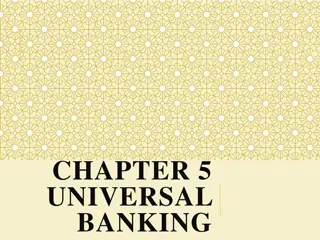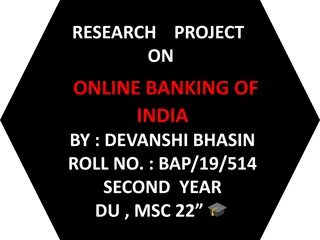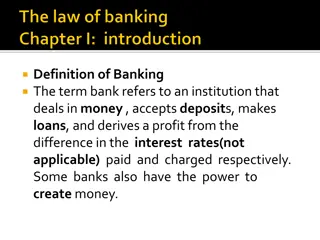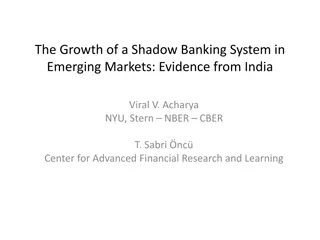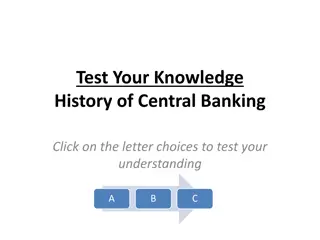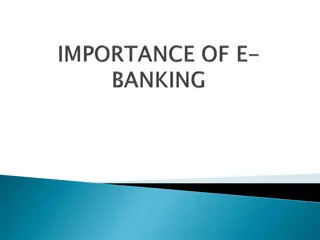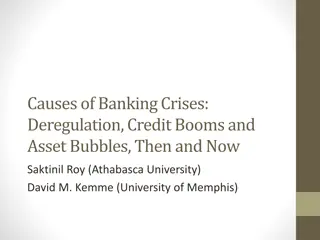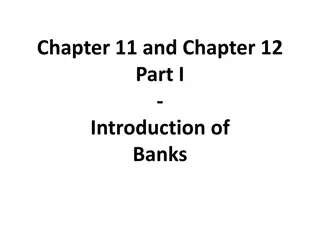Understanding Banking Relationships and Responsibilities
Explore the intricate relationships and responsibilities in banking, from the roles of bankers as debt creators to customers as buyers of services. Learn about debtor-creditor relations, creditor-debtor relationships, and the dynamics of beneficiary-trustee interactions in the banking sector.
Download Presentation

Please find below an Image/Link to download the presentation.
The content on the website is provided AS IS for your information and personal use only. It may not be sold, licensed, or shared on other websites without obtaining consent from the author. Download presentation by click this link. If you encounter any issues during the download, it is possible that the publisher has removed the file from their server.
E N D
Presentation Transcript
Abanker is the one who gets into debts and creates debts. H.L. HART the banker is one who receives money, collects cheques and drafts, for customers, with an obligation to honour the cheques drawn by customers from time to time subject to availability of amounts in the account. Section 3 of NI ACT 1881, and Section 2 of BILL OF EXCHANGE ACT 1882. state that the term banker includes person or corporation or a company acting as banker. Under Section 5 (1) of Banking Regulations of 1949, a banking company is defined as any company which transacts banking business. Under Section 5 (1) B , banking business means accepting for the purpose of landing or investment, deposits of money from the public, repayable on demand or otherwise withdrawable by cheque , draft or otherwise.
CUSTOMER A person who buys goods or services from a shop or a business entity. A person you deal with as a business entity. There is no statutory definition. A person/ company/entity who has an account with a bank is a customer. There is no unanimity as regards to the time period of the dealings. A casual transaction like encashment of a cheque does not entail a person to be customer. The duration of association of the customer with the bank is of no essence. A customer is one who has an account with the bank and to whom the banks undertakes to extend business of banking.
DEBTOR-CREDITOR When the customer avails a loan or relationship with the banker undergoes a change to what it is when he is a deposit holder. Since the funds are lent to the customer , he becomes the borrower and the banker becomes the lender. The relation is the debtor- creditor relation, the customer being a debtor and the banker a creditor an advance then his
RELATIONSHIP CREDITOR-DEBTOR Relationship between the customer having a deposit account and the banker. Depositor is the lender and the banker is the borrower. Depositor is the creditor and the banker is the debtor. The money handed over to the bank is a debt. The money once deposited in the bank becomes the money of the bank and it is prerogative of the bank to use that money as it deems fit. The depositor remains a creditor that too an unsecured creditor
BENEFICIARY-TRUSTEE If a customer keeps certain valuables or securities with the bank for safe-keeping or deposits a certain amount of money for a specific purpose, becoming a bailee, is also a trustee. The money or the securities so kept are not at the disposal of the bank. The banker cannot utilize those moneys or securities as he desires since the money does not belong to him. Here there is delivery of goods or securities from one person to the other which amounts to the bailment. As per section 148 of Indian Contract Act 1872, the delivery of goods from one person to the other for some purpose upon the contract that the goods will be returned when the purpose is accomplished. The customer is the bailer and the banker is the bailee. the banker, besides
PRINCIPAL-AGENT Banks provide ancillary services such as collection of cheques, bills etc.They also undertake to pay regularly the electricity bills, phone relationship arising out of these ancillary services is of principal-agent between the customer and the bank. The relationship seizes once the customer dies, becomes insane or becomes insolvent. The proceedes of the cheques sent for collection,which are in transit, not created to the customer account are not the moneys of the banker till such time as they are credited into the customer account. bills etc. The
RIGHTS OF BANKER Right of general lien- Lien is the right of the creditor to retain the goods and securities owned by the debtor untill the debt due from him is paid. It conferes upon the creditor to retain the securities of the debtor. It does not confer the right to sell. There are two types of liens General lien and particular lien. Section 171 of Indian contract Act 1872 conferes general lien on bankers. Bankers lien is tantamount to implied pledge. The reason being the banker is bestowed with a right even to sell securities without the intervention of the court. Pledge Section 172 of Indian contract Act 1872- bailment of goods as security for payment of a debt or performance.
Right of set off The mutual claims of a debtor and a creditor are adjusted together and only the remainder amount due is payable. Right of appropriation - If the customer has more than one loan account , the customer can direct the repayment of the loan as credit into any other accounts. If there is no specific directions from the customers the banker has a right to appropriate as per his choice. Right to charge interest- As a creditor the banker has right to charge interest on the funds he lends as per the norms and as per the contract.







